SWE: A Support System for Illinois'
Female Engineering Students
September 23, 2014
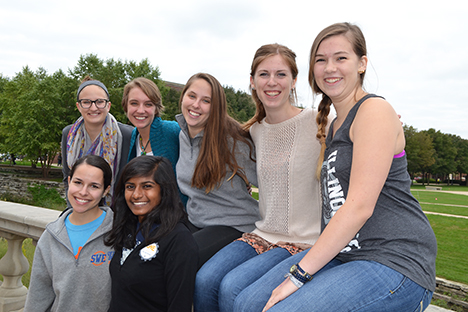
SWE members (clockwise from top left): Grace Pakeltis, Outreach Co-Director; Lauraleigh Heffner, Nominating Committee; Stephanie Lona, President; Emily Matijevich, External Vice President; Julia Hardy, Outreach Co-Director; Camilia Amithirigale, Webmaster; Rachel Beck, Nominating Committee
While the Society of Women Engineers (SWE) is a national organization, for many of the 400 female engineering students at Illinois who are members, it's a whole lot more than just a professional organization. It's a support system that began when they were still in high school, deciding which school to attend. And once they arrived on campus, SWE became a ready-made family and even helped shape who they became during their time at Illinois. Finally, SWE helps its members in their quest for careers once they leave here. And in between? SWE members say it makes Engineering at Illinois a lot more fun.
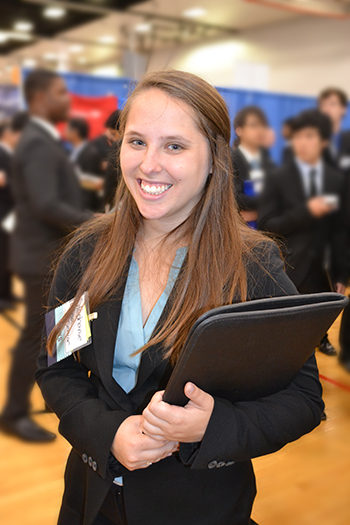
SWE President Stephanie Lona
For example, SWE President Stephanie Lona indicates that even before she stepped onto campus as a freshman, the organization had already made an impact.
A senior in Engineering Physics with a concentration in Computer Science, Lona didn't always want to study engineering at Illinois. She wanted to study forensic science at Loyola. (She admits to watching too many CSI shows.) Then, in her junior year, she took physics, which she didn't like at first. But when she realized it was basically math and that she was good at it, she chose it for her career. "I knew I wanted to do something in math and science, because that was always what I excelled in." And once Illinois accepted her, coming here was a no-brainer. "We have one of the top engineering physics schools in the country, so that was an obvious choice."
Her introduction to SWE was via a letter she received her senior year inviting her to Little Sisters' Weekend for girls admitted to Engineering. "It's a great event, and that's what got me in SWE," she admits. "So I have a special place in my heart for it."
SWE's next Little Sisters' Weekend will be in spring 2015, when each prospective student will be paired with a SWE mentor in her discipline (if possible), stay in her mentor's dorm room or apartment, and participate in activities designed to help high school girls understand what engineering is. SWE has embraced this emphasis because some members admit that as youngsters, not only were they NOT considering careers in engineering—they weren't even sure what it was.
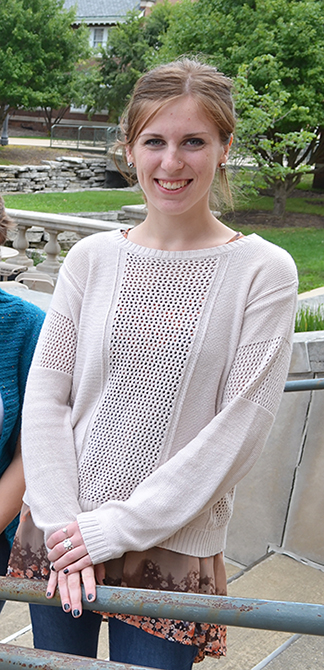
SWE External Vice President Emily Matijevich
Like External Vice President Emily Matijevich, who decided to be an engineer her senior year of high school, "When my parents said, ‘You should apply for engineering!'" she admits. So like a dutiful daughter, she did.
Long interested in math and science, she had wanted to be an architect—or a doctor. "I didn't understand quite what engineering was," she admits. Her senior year, a few teachers who had studied engineering started talking it up, but it wasn't until her first semester at Illinois that she finally discovered what it really was. She chose bioengineering, thinking to do pre-Med; now the junior hopes to do Prosthetics and Orthotics research.
SWE Outreach
Passionate about engineering, Matijevich and friends hope to change this scenario for some girls by introducing engineering as a viable career option much earlier. According to Matijevich, SWE's four outreach themes convey what engineers do:
- Engineers shape the future.
- Engineers are creative problem solvers. ("Girls love the creativity aspect of it," she says.)
- Engineers are essential to our health, happiness, and safety. ("A lot of girls are really excited about helping people," acknowledges Matijevich.)
- Engineers change the world ("Showing them again what a big impact we can make," she says).
Also passionate about outreach, SWE Outreach Director Julia Hardy says SWE exposes kids to engineering and breaks down misconceptions, depending on the age group:
"When they're younger, they really don't know what it is; we're trying to get them the best experience, expose them to all different types of engineering, what real engineering really is, because it's a lot of creative problem solving, and they don't really think of that. In kindergarten...they all just think we drive trains!"
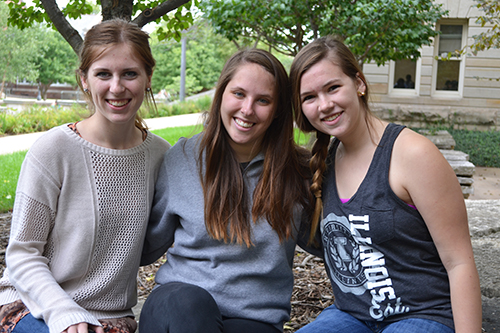
Left to right: Emily Matijevich, Stephanie Lona, and Julia Hardy
Hardy says high-schoolers "have this preconception; we work on breaking that down, showing them that it's more than just what you think it is, and how it can really help you, no matter what you want to go into. Engineering is great because it's applicable to practically everything." Hardy also says they actually do engineering design projects with them, so they "really experience it fully in terms of what they're interested in; get them excited about it.
One motive regarding outreach is to increase the number of women who choose careers in engineering. Engineering has traditionally been a "boys' club, and while the percentage of women majoring in engineering at Illinois is increasing, SWE hopes to further improve the ratio of men to women in the classroom for all the engineering disciplines. What Matijevich has experienced in Bioengineering is nearly 50/50, but Lona has not encountered such even numbers in Physics and Computer Science: "I've been the only girl in 30-person classes before," she admits.
Despite the high male-to-female ratio, she hasn't found it to be a detriment. "I've never felt in my classes at any disadvantage at all," she continues. "I feel like being a woman is an advantage, because you stand out already just by being one of the few women. And then when you prove that you are just as good as the guys, people respect you and value your opinion."
SWE: A Support System
In addition to opportunities for outreach, SWE fosters relationship-building among female students, one reason Lona has gotten so heavily involved: "SWE is a great support system for girls in engineering, and I think it's really essential to have that support system, and I like seeing girls getting involved; it's exciting. I like being a part of making that happen."
Matijevich agrees that the support system is one of SWE's strengths: "Having friends in engineering who understand what I'm going through. Most of my best girlfriends are in engineering."
For example, the SWE office in the basement of Engineering Hall is clearly a hang-out joint for many SWE officers, who, in between classes, can be found shoulder to shoulder around the table studying, or camped out on the overstuffed beige couch, which they've even nicknamed: "the SWOuch." Some Saturdays, the office hosts a Bagel Break, so girls can drop by and casually meet with corporate representatives on campus.
Participating in SWE doesn't just help in relationship building; Lona says it helped change her personality from a timid wall flower to that of a leader: "I used to be very shy, and not very outspoken when I started. SWE really helped me to gain better communication skills and be more outgoing. In high school, I could never have imagined myself in a leadership position at all. I was petrifyingly shy in high school; I didn't really talk to many people; I just kept to myself. But I am not like that at all anymore."
Professional Development
Another benefit of SWE is its professional development opportunities: "You don't get that in the classrooms," says Matijevich. "It's really intimidating walking into a career fair without all of these workshops that we hold."
For example, SWE recently hosted "Be Professional," a professional development event where 10 to 15 company representatives conducted workshops, which around 70 students attended.
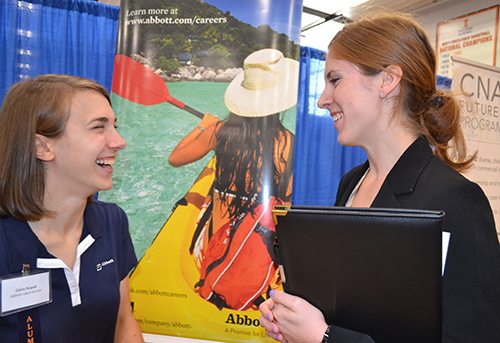
Emily Matijevich (right) chats with Abbott recruiter Claire Slupski at a recent engineering job fair. A May 2013 Illinois graduate, Slupslki was involved in SWE when she was an engineering student on campus.
Matijevich says one particularly unique and helpful workshop about "branding yourself" emphasized that at a school like Illinois, everyone has great grades and is competitive in engineering. The workshop advised students to "brand" themselves to stand out from the crowd by keying in on specific adjectives to describe themselves, then making that their personality when talking with a recruiter at a fair, or during an interview. What is Matijevich's brand?
"I think I'm going to emphasize how I really like to be creative in engineering, because I think that's something more unique; that's something that I'm going to talk about at the career fair next week, hopefully."
According to Lona, around 200 of SWE's members are very active, attending about 5 events a semester. Helping run the organization and plan and host its many events are 9 committees and 14 directors, including 5 executive members.
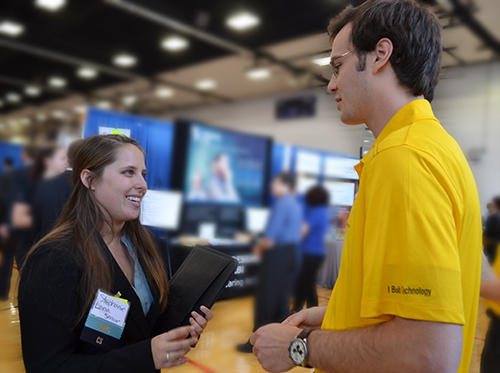
At a recent engineering job fair, Stephanie Lona does some networking on behalf of SWE. The recruiter with whom she is chatting is Illinois alumnus Don Ferrell, an engineer with Union Pacific.
For example, Lona has been planning this fall's trip to SWE's National Conference in LA from October 22–26. Around 50 Illinois students will attend the popular event, which includes professional development workshops; a career fair, and networking. "And the food's really good," Lona admits. While at the conference, she and several other Illinois students will help at the "Invent It; Build It" outreach, which features design challenges and hands-on activities aimed at getting local middle school girls interested in engineering. Adds Lona, "They're inspired by seeing us and the professionals that are there."
As External Vice President, Matijevich handles corporate relations. SWE has a whole database of companies who have worked with or expressed interest in working with SWE, which she accesses to schedule company representatives for SWE events, such as its two annual conferences (fall and spring). SWE's Leadership Series hosts 10 seminars a semester, hour-long events where representatives from different companies present what their company does, then address a special topic, such as how to improve one's resume, build a network, or transition from college to industry. In addition, a corporate sponsor attends each of SWE's monthly meetings, some of their most heavily attended events.
SWE Goals
SWE recently established goals; one is to impact a wider range of girls by reaching out farther than just Champaign-Urbana. They've begun partnering with a school in Naperville; plus, Matijevich and another SWE member plan to help with the science program at a small school in Jamaica, Illinois, during October.
Another goal is giving back to the community; SWE holds workshops where girls teach each other things, or folks from other societies or campus groups, such as iRobotics, come in and teach the girls things.
So what kind of impact has SWE had on its members? According to Matijevich, participating in SWE has been her most memorable experience at Illinois so far.
"When I look back on my college experience, SWE will definitely be the thing I remember the most, I think. It makes engineering more fun."
"It does," agrees Lona.
Story and photos by Elizabeth Innes, Communications Specialist, I-STEM Education Initiative
More: SWE, Women in STEM, 2014
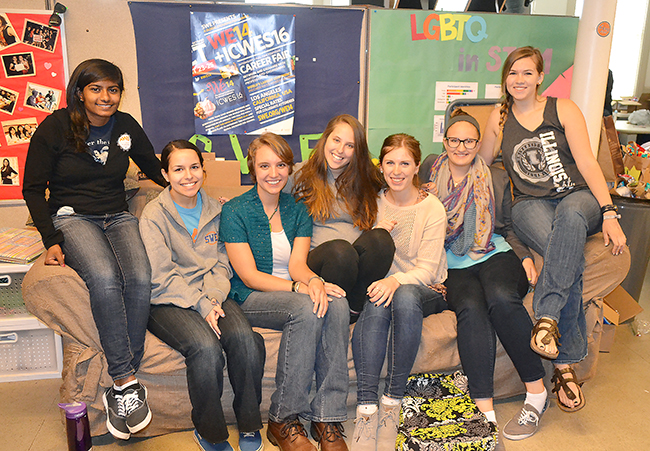
SWE members enjoy the overstuffed couch in their Engineering Hall office.













.jpg)
















